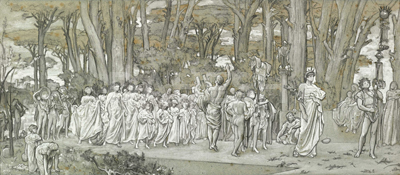Frederic, Lord Leighton, P.R.A. (British, 1830–1896)
Study for Daphnephoria, before 1876
Charcoal and pencil heightened with white wash on blue paper, 8 x 17 3/4 in.
2012.10

The Daphnephoria took place every nine years in the ancient Greek city of Thebes, commemorating the Thebans victory over the Aeolians. The event honored the god Apollo, whose floral symbol was the laurel (daphne in Greek), and was centered around a procession led by the Daphnephorus (laurel-bearer), a young boy dressed as Apollo. Leighton’s representation of the festival was one of four major frieze-like compositions — two of which are represented in the Museum’s collection by oil studies for The Syracusan Bride (ca. 1865) and Captive Andromache (ca. 1888). As a major proponent of classicism in contemporary art, Leightonclosely studied works from ancient Greece and likely derived the processional style mode from sculpted friezes like the Panathenaic procession from the Parthenon (447-432 BCE), which he could have seen at the British Museum. In this charcoal, chalk, and pencil study, Leighton gives the figures a highly sculptural quality. Folds of drapery and figural musculature are emphasized, an aspect of the work that is somewhat diminished in the final painting (1876, Lady Lever Art Gallery, Liverpool, UK).


